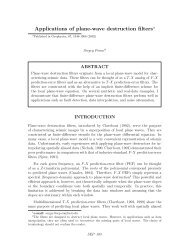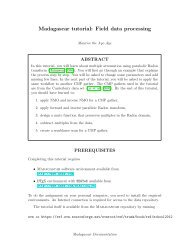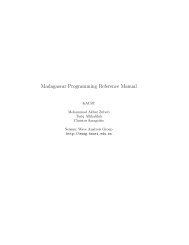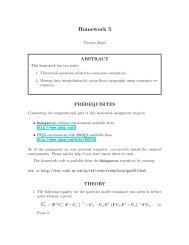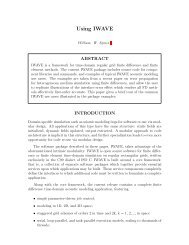Fomel, Ying, & Song 18 Lowrank <strong>wave</strong> <strong>extrapolation</strong> let ⎡ ⎤ m 1 ⎢ ⎥ W = ⎣ . ⎦ m Nx (A-4) be the row partitioning of the matrix W. The algorithm takes the following steps: 1: Select uniform randomly a set of t columns and obtain an N x × t tall matrix 2: Perform pivoted QR algorithm on the rows of this tall matrix and denote the first r rows selected by {i 1 , . . . , i r } 3: The matrix V ∗ is ⎡ ⎤ m i1 V ∗ ⎢ ⎥ = ⎣ . ⎦ . (A-5) m ir Once both U and V ∗ are identified, the last task is to compute the r × r matrix M for W ≈ UMV ∗ . Minimizing min M ‖W − UMV∗ ‖ F (A-6) yeilds M = (U) † W(V ∗ ) † where † stands for the pseudo-inverse. However, this formula requires taking matrix product with W, which takes O(t N 2 x) steps. In order to achieve linear scaling, the fourth idea of our approach is to select randomly a set of t rows A and a set of t columns B and minimize min M ‖W(A, B) − U(A, :) M V(B, :)∗ ‖ F . (A-7) The solution for this problem is M = (U(A, :)) † W(A, B) (V(B, :) ∗ ) † . (A-8) Let us now discuss the overall cost of this algorithm. Random sampling of t rows and t columns of the matrix W clearly takes O(t N x ) steps. Pivoted QR factorization on the projected columns { ˜w 1 , . . . , ˜w Nx } takes O(t 2 N x ) steps and the cost for for the pivoted QR factorization on the projected rows. Finally, performing pseudo-inverses takes O(t 3 ) steps. Therefore, the overall cost of the algorithm is O(t N x ) + O(t 2 N x ) + O(t 3 ) = O(t 2 N x ). As we mentioned earlier, in practice t = O(r log N x ). Hence, the overall cost is linear in N x . REFERENCES Alkhalifah, T., 1998, Acoustic approximations for processing in transversely isotropic media: Geophysics, 63, 623–631. ——–, 2000, An acoustic <strong>wave</strong> equation for anisotropic media: Geophysics, 65, 1239– 1250.
Fomel, Ying, & Song 19 Lowrank <strong>wave</strong> <strong>extrapolation</strong> Alkhalifah, T., and S. Fomel, 2010, Source-receiver two-way <strong>wave</strong> <strong>extrapolation</strong> for prestack exploding-reflector modeling and migration, in 80th Ann. Internat. Mtg: Soc. of Expl. Geophys., 2950–2955. Alkhalifah, T., and I. Tsvankin, 1995, Velocity analysis for transversely isotropic media: Geophysics, 60, 1550–1566. Aminzadeh, F., J. Brac, and T. Kunz, 1997, 3-D salt and overthrust models: SEG. Billette, F. J., and S. Brandsberg-Dahl, 2005, The 2004 BP velocity benchmark: 67th Annual EAGE Meeting, EAGE, Expanded Abstracts, B305. Chu, C., and P. Stoffa, 2008, A pseudospectral-finite difference hybrid approach for large-scale seismic modeling and RTM on parallel computers, in 78th Ann. Internat. Mtg: Soc. of Expl. Geophys., 2087–2091. Du, X., R. P. Fletcher, and P. J. Fowler, 2010, Pure P-<strong>wave</strong> propagators versus pseudo-acoustic propagators for RTM in VTI meida: 72nd Annual EAGE Meeting, EAGE, Expanded Abstracts, C013. Engquist, B., and L. Ying, 2009, A fast directional algorithm for high frequency acoustic scattering in two dimensions: Commun. Math. Sci., 7, 327–345. Etgen, J., 1986, High order finite-difference reverse time migration with the two way nonreflecting <strong>wave</strong> equation, in SEP-48: Stanford Exploration Project, 133–146. Etgen, J., and S. Brandsberg-Dahl, 2009, The pseudo-analytical method: application of pseudo-Laplacians to acoustic and acoustic anisotropic <strong>wave</strong> propagation, in 79th Ann. Internat. Mtg: Soc. of Expl. Geophys., 2552–2556. Fomel, S., 2003a, Theory of differential offset continuation: Geophysics, 68, 718–732. ——–, 2003b, Velocity continuation and the anatomy of residual prestack time migration: Geophysics, 68, 1650–1661. ——–, 2004, On anelliptic approximations for qP velocities in VTI media: Geophys. Prosp., 52, 247–259. Fowler, P., X. Du, and R. P. Fletcher, 2010, Recursive integral time <strong>extrapolation</strong> methods for scalar <strong>wave</strong>s, in 80th Ann. Internat. Mtg: Soc. of Expl. Geophys., 3210–3215. Golub, G. H., and C. F. Van Loan, 1996, Matrix computations: John Hopkins. Goreinov, S., E. Tyrtyshnikov, and N. Zamarashkin, 1997, A theory of pseudoskeleton approximations: Linear Algebra Appl., 261, 1–21. Gu, M., and S. C. Eisenstat, 1996, Efficient algorithms for computing a strong rankrevealing QR factorization: SIAM J. Sci. Comput., 17, 848–869. Johnson, W. B., and J. Lindenstrauss, 1984, Extensions of Lipschitz mappings into a Hilbert space, in Conference in modern analysis and probability (New Haven, Conn., 1982): Amer. Math. Soc., volume 26 of Contemp. Math., 189–206. Magen, A., 2002, Dimensionality reductions that preserve volumes and distance to affine spaces, and their algorithmic applications, in Randomization and approximation techniques in computer science: Springer, volume 2483 of Lecture Notes in Comput. Sci., 239–253. Pestana, R. C., and P. L. Stoffa, 2011, Using the rapid expansion method for accurate time-stepping in modeling and reverse-time migration: Geophysics, 76, S177–S185. Reshef, M., D. Kosloff, M. Edwards, and C. Hsiung, 1988, Three-dimensional acoustic modeling by the Fourier method: Geophysics, 53, 1175–1183.
- Page 1 and 2: Seismic wave extrapolation using lo
- Page 3 and 4: Fomel, Ying, & Song 3 Lowrank wave
- Page 5 and 6: Fomel, Ying, & Song 5 Lowrank wave
- Page 7 and 8: Fomel, Ying, & Song 7 Lowrank wave
- Page 9 and 10: Fomel, Ying, & Song 9 Lowrank wave
- Page 11 and 12: Fomel, Ying, & Song 11 Lowrank wave
- Page 13 and 14: Fomel, Ying, & Song 13 Lowrank wave
- Page 15 and 16: Fomel, Ying, & Song 15 Lowrank wave
- Page 17: Fomel, Ying, & Song 17 Lowrank wave





